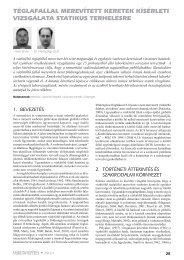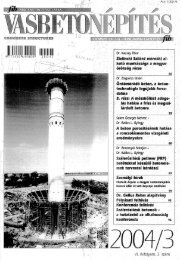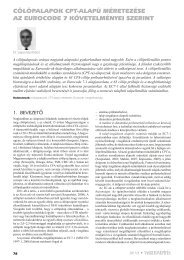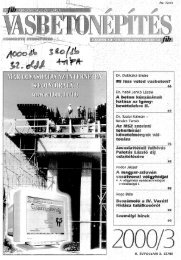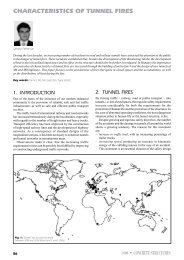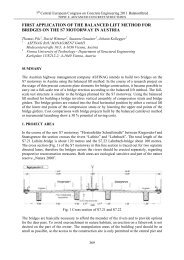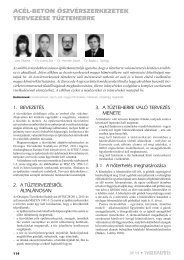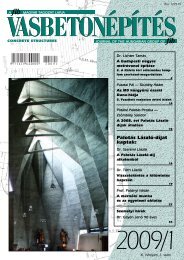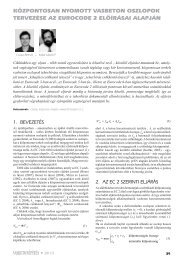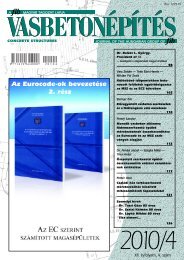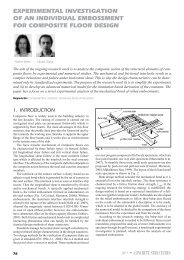early age shrinkage cracking of fibre reinforced concrete
early age shrinkage cracking of fibre reinforced concrete
early age shrinkage cracking of fibre reinforced concrete
- No tags were found...
You also want an ePaper? Increase the reach of your titles
YUMPU automatically turns print PDFs into web optimized ePapers that Google loves.
EARLY AGE SHRINKAGE CRACKING OF FIBREREINFORCED CONCRETEOlivér Fenyvesi - Zsuzsanna JózsaConventional steel <strong>reinforced</strong> <strong>concrete</strong> is <strong>of</strong>ten sensitive to <strong>cracking</strong>, and these cracks could be the result <strong>of</strong><strong>early</strong> <strong>age</strong> shrink<strong>age</strong>. Cracks can cause the corrosion <strong>of</strong> steel reinforcements reducing the lifetime <strong>of</strong> <strong>concrete</strong>structures. To reduce this problem <strong>fibre</strong> <strong>reinforced</strong> <strong>concrete</strong> (FRC) is one possible solution. Laboratory testshave been carried out according to the Austrian FRC technical specification, in particular with regard to<strong>early</strong> <strong>age</strong> shrink<strong>age</strong> <strong>cracking</strong>. Four different relatively thin and short <strong>fibre</strong> types were used: fabricated frompolypropylene, polyacrylnitrile and non alkaline resistant E-glass. In this paper the relationship between thedos<strong>age</strong> <strong>of</strong> <strong>fibre</strong>s and <strong>early</strong> <strong>age</strong> shrink<strong>age</strong> <strong>cracking</strong> tendency was tested and effectiveness <strong>of</strong> <strong>fibre</strong> types arecompared. During the laboratory tests compressive strength was also tested. In case <strong>of</strong> every <strong>fibre</strong> type, therelationship between dos<strong>age</strong> and crack tendency were linear. If we test a <strong>fibre</strong> type again but with a referencemix with higher crack tendency, the two linear curves will approach each other if dos<strong>age</strong> is increased.Finally, further possibilities are described with testing more <strong>fibre</strong> types and higher dos<strong>age</strong>s in the future.Keywords: shrink<strong>age</strong>, shrink<strong>age</strong> <strong>cracking</strong>, <strong>early</strong> <strong>age</strong> shrink<strong>age</strong>, FRC, polymeric <strong>fibre</strong>s, glass <strong>fibre</strong>s1. INTRODUCTIONIn <strong>concrete</strong>, mortar and cement paste shrink<strong>age</strong> takes placefrom the very beginning. This is caused by water movementin the porous and rigid body. During the hydration <strong>of</strong> cement,while the cement paste is plastic, it undergoes a volumetriccontraction (autogenous shrink<strong>age</strong>) which magnitude is<strong>of</strong> the order <strong>of</strong> one per cent <strong>of</strong> the absolute volume <strong>of</strong> drycement. However, the extent <strong>of</strong> hydration prior to setting issmall, and once a certain rigidity <strong>of</strong> the system has developed,the contraction induced by the loss <strong>of</strong> water by hydration isgreatly restrained (Neville, 1995). Withdrawal <strong>of</strong> water from<strong>concrete</strong> or mortar or cement paste stored in unsaturated aircauses drying shrink<strong>age</strong>. A part <strong>of</strong> this drying shrink<strong>age</strong> isirreversible and should be distinguished from the reversiblemoisture movement caused by alternating stor<strong>age</strong> under wetand dry condition (Neville, 1995; Grube, 2003).Influencing factors <strong>of</strong> shrink<strong>age</strong> in mix design:− cement content <strong>of</strong> paste− specific surface area <strong>of</strong> cement− fine aggregate content (under 0.125 particle size)− specific surface area <strong>of</strong> fine aggregate− water-cement ratio− total aggregate content− type <strong>of</strong> aggregate− water absorption capacity/water content <strong>of</strong> aggregate− applied admixtures− compacting rate <strong>of</strong> paste− porosity− other added components e.g. <strong>fibre</strong>s.Shrink<strong>age</strong> <strong>of</strong> <strong>concrete</strong> depends on the temperature <strong>of</strong><strong>concrete</strong> and its surroundings, on relative humidity and on thevelocity <strong>of</strong> air movement as well as the curing and composition<strong>of</strong> the <strong>concrete</strong>.The importance <strong>of</strong> shrink<strong>age</strong> in structures is largely relatedto <strong>cracking</strong>. Time has a two-fold effect from this point <strong>of</strong>view: the strength increases, thereby reducing the probability<strong>of</strong> <strong>cracking</strong>, but on the other hand, the stress induced byshrink<strong>age</strong> also increases. If stress reaches the tensile strength<strong>of</strong> <strong>concrete</strong>, cracks appear on the structure or specimen (CEB,1992; Neville, 1995).Fibre <strong>reinforced</strong> <strong>concrete</strong> (FRC) is a possible solution toavoid <strong>early</strong> <strong>age</strong> shrink<strong>age</strong> <strong>cracking</strong> (Balázs, Lublóy, 2007).Earlier in Hungary, asbestos and celluloid <strong>fibre</strong>s were usedto produce <strong>fibre</strong> <strong>reinforced</strong> cementitious products (mainlyro<strong>of</strong>ing elements and pipes) under the trademark “Eternit”.These products have disappeared from the market, but theycan be found in old buildings. Asbestos <strong>fibre</strong>s have very smalldiameter, <strong>of</strong>ten smaller than 10 µm, and provide very highstrength, but may cause serious health problems (e.g. lungcancer on inhalation). That is the reason why, from a medicalpoint <strong>of</strong> view, the smallest allowed diameter <strong>of</strong> <strong>fibre</strong>s is 7 µm,and on the market there are <strong>fibre</strong>s with a diameter between9 and 500 µm. Nowadays there are <strong>fibre</strong>s made from steel,stainless steel, AR-glass (alkaline resistant), E-glass (nonalkaline resistant), polypropylene, polyacrylnitrile, nylon,carbon, etc. (Józsa et al., 2005).To study crack tendency <strong>of</strong> different cement types Balázs etal. (1979) have made ring tests, where the time <strong>of</strong> <strong>cracking</strong> wasmeasured. Crack tendency <strong>of</strong> FRCs was investigated by Shah,Weiss, in 2006, Aly, Sanjayan and Collins in 2008 and Alyand Sanjayan in 2009. Restrained shrink<strong>age</strong> was also studiedby Salah and Lange in 2001. Recently another test method isused to evaluate restrained <strong>early</strong> <strong>age</strong> shrink<strong>age</strong> according tothe Austrian <strong>fibre</strong>-<strong>concrete</strong> technical specification describedin Faserbeton Richtlinie (2002, 2008). This method was usedby Józsa et al. in 2005, and by Schmidt in 2005 and also inCONCRETE STRUCTURES • 2010 61
86 1966457 1968015 1606089 1984455 Testiert87 1792825 1792634 1776650 1682443 Testiert88 1618080 1659683 1723302 1618886 Testiert89 1964103 1964093 1937004 1963476 Testiert90 1662214 1745513 1722620 1722536 Testiert91 1966868 1794467 1965979 1793183 Testiert92 1660449 1617777 1756298 1713561 Testiert93 1747825 1417472 1425778 1478903 Testiert94 1747566 1747964 1747870 1694693 Testiert95 1721498 1616105 1615818 1691858 Testiert96 1745018 1983948 1984031 1984044 Testiert97 1966379 1761607 1322396 1570047 Testiert98 1644575 1644106 1620515 1687752 Testiert99 1296648 1812420 1794438 1965351 Testiert100 1967812 1967524 1967650 1758610 Testiert101 1983809 1725384 1983621 1726163 Testiert102 1450549 1712041 1726024 1715556 Testiert103 1964394 2018469 1967139 1968549 Testiert104 1667222 1556676 1469242 Testiert105 2005605 2005731 1985441 1821589 Testiert106 1341373 Testiert107 1618530 Testiert108 1747906 TestiertHinweise:Bitte beachten Sie auch die Testatliste des Fachgebiets Wasserbau. Nur wenn beide Übungsteiletestiert wurden wird die Studienleistung als „bestanden“ in TUCaN eingetr<strong>age</strong>n!Kraft 2013-07-18 4/4
Fig. 12: Aver<strong>age</strong> summarized crack lengths (<strong>of</strong> four specimens) <strong>of</strong> FRCmade with glass and PAN <strong>fibre</strong>s <strong>of</strong> 12 mm length after curing in tumbler-drierFig. 15: Aver<strong>age</strong> summarized crack lengths (<strong>of</strong> four specimens) <strong>of</strong> twomixes <strong>of</strong> FRC made glass <strong>fibre</strong>s <strong>of</strong> with 12 mm length after curing in windtunnelFig. 13: Aver<strong>age</strong> summarized crack lengths (<strong>of</strong> four specimens) <strong>of</strong> FRCmade with glass and PAN <strong>fibre</strong>s <strong>of</strong> 12 mm length after curing in windtunnelFig. 14: Aver<strong>age</strong> summarized crack lengths (<strong>of</strong> four specimens) <strong>of</strong> FRC madewith glass and PAN <strong>fibre</strong>s <strong>of</strong> 12 mm length after curing in tumbler-drierthe tested PAN <strong>fibre</strong> is as effective as the glass <strong>fibre</strong>, becausein one kg there are more pieces <strong>of</strong> <strong>fibre</strong>, but if we study real<strong>fibre</strong> effectiveness, glass <strong>fibre</strong> is better. The reason <strong>of</strong> this effectis the higher Young’s modulus <strong>of</strong> glass <strong>fibre</strong>s.The specialty <strong>of</strong> the applied experimental method is that ifwe change the cement type or the aggregate, crack tendencyis changing, so we can not compare our experimental resultswith findings that others measured in other laboratory with adifferent reference mix. If we repeat an experiment sequence<strong>of</strong> one <strong>fibre</strong> type with different mixture with different cracktendency and compare with the first sequence, the results willbe different, as shown in Figs. 15 and 16. In these curvesone point represents the aver<strong>age</strong> summarized crack length <strong>of</strong>Table 3: Classes <strong>of</strong> crack tendency according to Faserbeton Richtlinie(2002, 2008)YearClassesReference mixtureAver<strong>age</strong> crack length [%]FRC mixtureFS 1 100 602002FS 2 100 202008 FS 100 20Fig. 16: Aver<strong>age</strong> summarized crack lengths (<strong>of</strong> four specimens) <strong>of</strong> twomixes <strong>of</strong> FRC made with glass <strong>fibre</strong>s <strong>of</strong> 12 mm length after curing intumbler-drierfour ring specimens. The reference mixtures (made without<strong>fibre</strong> reinforcement) have different crack tendency as theother sequence’s reference mix had. If we compare the results<strong>of</strong> the two sequences, we can see that the two linear curvesapproach each other. This means that theoretically there isa significant point where the two lines are meeting. In ourexperiences we could not reach this point, because one <strong>of</strong> ourlines had already reached the horizontal axis before crossing,so there were no cracks registered in case <strong>of</strong> the first mix, atthe highest 1.0 kg/m 3 dos<strong>age</strong> <strong>of</strong> <strong>fibre</strong>s. Further investigationsare needed with a reference mix with higher crack tendency toreach this point where the lines are meeting. It could happenthat we cannot reach this point, because the higher porosity<strong>of</strong> <strong>concrete</strong> caused by the higher <strong>fibre</strong> dos<strong>age</strong> will deform thelinear curves or before this point every mixture will reach thezero crack length.5. CONCLUSIONSIn this paper <strong>early</strong> <strong>age</strong> shrink<strong>age</strong> <strong>cracking</strong> (caused by autogenousand drying shrink<strong>age</strong>) <strong>of</strong> different <strong>fibre</strong> <strong>reinforced</strong> <strong>concrete</strong>s(FRC) were investigated. Variable parameters were the typeand the dos<strong>age</strong> <strong>of</strong> <strong>fibre</strong>s. Four types <strong>of</strong> <strong>fibre</strong>s were testedfabricated from glass, PAN and PP. To evaluate effectiveness<strong>of</strong> different types <strong>of</strong> <strong>fibre</strong>s, a reference mix was producedwithout <strong>fibre</strong> reinforcement. To measure the <strong>early</strong> <strong>age</strong> shrink<strong>age</strong>crack tendency ring test was used according to the Austrian<strong>fibre</strong> <strong>reinforced</strong> <strong>concrete</strong> technical specification described inFaserbeton Richtlinie (2002, 2008). For the ring test specialspecimens were fabricated and cured in wind tunnel in aclimatic room according to the Austrian technical specification.The length <strong>of</strong> every crack caused by <strong>early</strong> <strong>age</strong> shrink<strong>age</strong> wasregistered after the test. Further investigations were carried outby testing the specimens in standard tumbler-drier at 60 °C.Afterwards crack lengths were also registered.CONCRETE STRUCTURES • 2010 65
− The relationship between <strong>fibre</strong> dos<strong>age</strong> and <strong>early</strong> <strong>age</strong>shrink<strong>age</strong> crack tendency was found to be linear in case <strong>of</strong>every tested type <strong>of</strong> <strong>fibre</strong>s. This means that if we apply ahigher dos<strong>age</strong> <strong>of</strong> glass or polymer <strong>fibre</strong>s in <strong>concrete</strong>, a lowercrack tendency is reached.− There is a significant difference between evaluating theresults by dos<strong>age</strong> in kg/m 3 or in V%. If we evaluate the <strong>early</strong><strong>age</strong> shrink<strong>age</strong> crack tendency by V% (and the geometry <strong>of</strong><strong>fibre</strong>s is the same e.g. the tested PAN and glass <strong>fibre</strong>s) wecan see the real effectiveness <strong>of</strong> a <strong>fibre</strong> type. Estimatingthe dos<strong>age</strong>s in V%, glass <strong>fibre</strong>s are better than polymer<strong>fibre</strong>s. But glass has higher density at the same time, so ifwe evaluate by the dos<strong>age</strong> <strong>of</strong> <strong>fibre</strong>s in kg/m 3 that meansmore pieces <strong>of</strong> PAN <strong>fibre</strong>s are compared with a few glass<strong>fibre</strong>s.− If we repeat our experiments with an other reference mixwhich has higher <strong>early</strong> <strong>age</strong> shrink<strong>age</strong> crack tendency andcompare the two resulted linear curves will be registered,they approach each other by ascendant dos<strong>age</strong> <strong>of</strong> <strong>fibre</strong>s.− As an additional result <strong>of</strong> our tests further investigationsare needed by testing other types <strong>of</strong> <strong>fibre</strong>s and higherdos<strong>age</strong>s <strong>of</strong> the tested <strong>fibre</strong>s to evaluate further relationshipsbetween <strong>early</strong> <strong>age</strong> shrink<strong>age</strong> crack tendency and <strong>fibre</strong>reinforcement.6. ACKNOWLEDGEMENTSAuthors wish to express their gratitude to Avers Ltd. andBaumbach Metall GmbH for giving free run <strong>of</strong> materials forpresent research; and to Csaba Gyömbér (Djember) for theimportant help in the laboratory works.7. REFERENCESAly, T., Sanjayan, J. G., Collins F. (2008), “Effect <strong>of</strong> polypropylene fibers onshrink<strong>age</strong> and <strong>cracking</strong> <strong>of</strong> <strong>concrete</strong>s” Materials and Structures 22 January2008 41:1741-1753Aly, T., Sanjayan, J. G. (2009), “Shrink<strong>age</strong> <strong>cracking</strong> <strong>of</strong> OPC-fiber <strong>concrete</strong> at<strong>early</strong> <strong>age</strong>” Materials and Structures 13 July 2009Balázs, Gy., Borján, J., Cary Silva, J., Liptay, A., Zimonyi, Gy. (1979), “Cracktendency <strong>of</strong> cement” (A cement repedésérzékenysége) Sci. publications(Tudományos közlemények) in Hungarian, 1979 Budapest, HU ISSN0324-3575Balázs, Gy. L. – Lublóy, É., „Residual compressive strength <strong>of</strong> fire exposed<strong>fibre</strong> <strong>reinforced</strong> <strong>concrete</strong>” Concrete Stuctures 2007, ISSN 14196441CEB (1992), CEB No. 183 „Durable Concrete Structures” - Design Guide;ISBN 978-0-7277-1620-0EN 206-1 – “Concrete part 1.: specifications, performance, production andcomformity” European CodeFaserbeton Richtlinie (2002), „Austrian <strong>fibre</strong>-<strong>concrete</strong> technical specification“2002 March (in German) Österreichische Vereinigung für Beton- undBautechnik, 63 p.Faserbeton Richtlinie (2008), „Austrian <strong>fibre</strong>-<strong>concrete</strong> technical specification“2008 (in German) Österreichische Vereinigung für Beton- und Bautechnik,97 p.Fenyvesi, O. (2006), „Early Age Shrink<strong>age</strong> Cracking <strong>of</strong> Fibre ReinforcedLightweight Aggregate Concrete” Proceedings <strong>of</strong> 6th International PhDSymposium in Civil Engineering (Eds. T. Vogel, N. Mojsilovic, P. Marti),Zürich 23-26 August, 2006 pp. 1-8.Grube, H. (2003), „Definitions <strong>of</strong> different types <strong>of</strong> shrink<strong>age</strong> – <strong>concrete</strong>”(Definition der verschiedenen Schwindarten) – Beton, 2003/12 pp. 603Józsa, Zs., Djember, C, Für Kovács, I., Seidl, Á. (2005), “Use <strong>of</strong> Glassand Synthetic Fibres Preventing Early Age Cracking <strong>of</strong> Normal andLightweight Concrete” Proc. 1st Central European Congress on ConcreteEngineering, 2006 Graz, Austria pp. 125-130.Neville, A. M. (1995), “Properties <strong>of</strong> <strong>concrete</strong>” 1995 ISBN: 0-582-23070-5Salah, A., Lange, D. A. (2001), “Creep, Shrink<strong>age</strong> and Cracking <strong>of</strong> RestrainedConcrete at Early Age” ACI Materials Journal, July-August 2001. pp.323-331Schmidt, M. (2005), „Baumbach Metall GmbH Product informations for PPfibers“ (in German), Baumbach Metall GmbHShah, H. R., Weiss, J. (2006), “Quantifying shrink<strong>age</strong> <strong>cracking</strong> in fiber<strong>reinforced</strong> <strong>concrete</strong> using the ring test” Materials and Structures RILEMonline 20 September 2006 39:887-899Wongtanakitcharoen, T., Naaman, A. E. (2006), “Unrestrained <strong>early</strong> <strong>age</strong>shrink<strong>age</strong> <strong>of</strong> <strong>concrete</strong> with polypropylene, PVA, and carbon fibers”Materials and Structures RILEM online 10 November 2006 40:289-300Olivér Fenyvesi (1981), MSc. in civil engineering (BME 2005). PhDStudent at Budapest University <strong>of</strong> Technology and Economics Department<strong>of</strong> Construction Materials and Engineering Geology. Main fields <strong>of</strong> interestare the <strong>early</strong> <strong>age</strong> (autogenous and drying) shrink<strong>age</strong> and <strong>early</strong> <strong>age</strong> shrink<strong>age</strong><strong>cracking</strong> in normal- and lightweight <strong>concrete</strong>s, the FRC, fiber <strong>reinforced</strong>lightweight <strong>concrete</strong>s, self compacting lightweight <strong>concrete</strong>s, buildingdiagnostics, building herit<strong>age</strong>. Member <strong>of</strong> Scientific Society <strong>of</strong> Silicate Industry(Concrete Division).Zsuzsanna Józsa (1950) PhD, associate pr<strong>of</strong>essor at the Department <strong>of</strong>Construction Material and Engineering Geology at Budapest University<strong>of</strong> Technology and Economics, architect, postgraduate diploma in buildingreconstruction. Her main fields <strong>of</strong> activities are lightweight aggregate <strong>concrete</strong>,non-destructive <strong>concrete</strong> testing, <strong>concrete</strong> corrosion and repair, thermal andmoisture properties <strong>of</strong> materials, thermal insulation and water-pro<strong>of</strong>ing, ro<strong>of</strong>tiles, wall construction, bricks and tiles, aerated <strong>concrete</strong>, environmentalcompatible building materials. She is member <strong>of</strong> IASS WG 18 “EnvironmentalCompatible Structures and Structural Materials”, Association for BuildingBiology, Hungarian Scientific Society <strong>of</strong> Building, Scientific Society <strong>of</strong> SilicateIndustry, Hungarian Group <strong>of</strong> fib, and is member <strong>of</strong> fib Commission 8 andearlier <strong>of</strong> TG 8.1: Lightweight aggregate <strong>concrete</strong>.66 2010 • CONCRETE STRUCTURES





